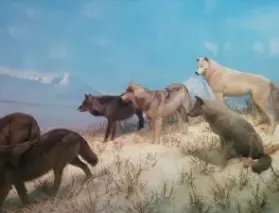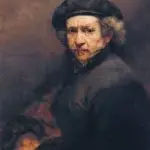
(Today’s article is by guest author Charles Riffee. For a brief bio, see below.)
In July of 2022 images from the James Webb Space Telescope first appeared on screens across the world. In one frame it looked as if galaxies warped by gravity were partners in dance. In another, light previously obscured from human experience was brought forward. Upon seeing these images, many individuals expressed conflicting emotions ranging from peaceful connectedness to fearful isolation. I resonated in similar ways, being both proud and humbled to see beauty in its rawest and purest form. I was witness to nature, and I am thankful for the artistry and observational inquiry that made this moment possible in human history.
Aside from graphic t-shirts, we do not normally equate NASA with art. Yet, the very task of “exploring the secrets of the universe for the benefit of all” is poetic.(1) It takes artistry to think through, create, and see what is previously hidden or unknown. When considering the myriad ways we experience life and come together, like those who identify as Spiritual Naturalists, it is good to recall the many pathways that express truth for our individual and corporate wellbeing. I argue that there are many places of commonality to be found within the diverse community of Spiritual Naturalists. There are points of intersection between pragmatism and intellectual speculation. A common lens by which one may witness this intersection is within the realm of artistic and observational inquiry.

For example, I offer to you one of my most cherished experiences. It involves time with a neighbor who crafted a wooden rocking horse for my children. He is a retired master carpenter, but also somewhat of a philosopher. While assisting me in transporting the oaken thoroughbred, he shared a bit of wisdom. He said, “I can build cabinets, chests, whatever you want, but in all that work it’s only the empty space that ever gets used.” My friend built a strong and safe structure enabling my children to imagine and play. But there was also something beyond the physical piece that was substantive. It was in play where the joy of the artist, the parent, and the child were found to be most complete. Each different person having varying thoughts, emotions, and backgrounds could point to this experiential understanding and find some semblance of truth. Joy was recognizable as both objective and subjective fact.
As Spiritual Naturalists, many find truth primarily through scientific and mathematical inquiry. Others find it in the humanities or in the wisdom of philosophical, ethical, and spiritual/religious inquiry. Still others find truth through greater self-awareness in meditation, mindfulness practices, or even forms of prayer. However, what is often left unspoken in any group dynamic are the motivations that led individuals to seek out a society with which to share ideas and belong. Many writers have shared stories of wonderment and growth as well as stories of hurt and disillusionment.
The latter may lead us to new paths, but it also can lead us to compartmentalize our search for truth. In that sense, our artistry and ability to inquire into all facets of human expression may become stunted and diminish the desire for a holistic view of the universe. When considering the example of the rocking horse one may be naturally drawn to the physical attributes of the toy over the existential or vice versa. The same is true in our search for knowledge. Despite the many mistakes we encounter in the search for truth, each area of human experience can add substance to where we find our intellectual and spiritual grounding.
One may look to science as a start. As a child, I remember reading Leon Letterman’s luridly entitled book The God Particle. Though he was a self-professed atheist utilizing theistic language, he was able to express the idea of the Higgs boson in a creative fashion that brought forward many individuals that would have otherwise never shared a conversation in search of truth. He shared the mythic tale of Democritus pondering the existence of atoms when observing the fragrance of fresh baked bread in the air. His writing enabled my conceptualization of this truth through the narrative of a soccer match where players effortlessly pass a ball invisible to outside observers.
It would take vast amounts of time, scientific progress, effort, engineering and trust to one day confirm what Letterman and other prominent particle physicists imagined to be true. It resulted in the building and completion of the Hadron Collider, which was both a monumental and artistic feat. This book was one example that provided me the intellectual freedom to seek understanding in multiple ways and through multiple lenses.
The study of human behavior and culture is no different. Mathematician John Nash developed a bargaining theory seeking common ground within human interaction and economic exchange. In it, Nash obscured the win/lose mentality of modern-day economics. Margaret McFarland is another example as she endeavored to enhance our understanding of childhood development. Though she did not publish like many of her contemporaries, McFarland’s focus on sharing knowledge was clear. She regularly consulted with the much beloved television star, Fred Rogers, who always wanted to speak to children in ways that were truthful and understandable.
Our journey for truth continues by courageously looking into the past. By looking backward in time, we can connect with other human beings and seek to understand truth within their artistic and observational frameworks. Often this is found in the study of philosophy and religion. Though Spiritual Naturalists speak of rejecting revelatory knowledge as a source of truth, one can find within those sources of sacred literature the human endeavor to understand internal and external natural phenomena. And, it can be a point of connection with those who claim religious theistic/nontheistic, agnostic, and atheistic worldviews.
In Hindu literature, the universe and time is conceptualized as both lengthy and cyclical. In the Ishawashya Upanishad, it reads “Having taken infinite out of the infinite, the infinite remains!” Though this text highlights a theistic source to the infinite, you see human expression endeavoring to explain and understand things beyond linear conceptions of time and the expansion and contraction of life within our universe. Within Judeo-Christian literature (The Hebrew Bible or the Christian Old Testament), we can look at Genesis 1:1-2:3 and witness the human endeavor to grasp both the linear sequence and growing complexity of biological life.
I for one find great value in trying to imagine the world through the eyes of those who came before us. It helps me to understand what aspects of our being has changed in response to our learning and differing circumstances. It helps me to see what thoughts connect us to those living centuries and millennia before. As humans, our desire for truth seems to be an inherent part of our nature.
As I consider the various questions raised within my work in healthcare, I find that many lie outside my scope of understanding. Questions involving the body, the mind, meaning, fulfillment, dignity, and justice are often raised within the confines of an infusion chair, consult room, or waiting area. I am thankful to have a team of medical, psycho-social, and spiritual care providers ready to offer their best selves whereby body, mind, and spirit are integrated more readily than at previous times.
With a sense of optimistic curiosity, I wonder what points of intersection there are within members of this and other similarly minded societies/associations or with others who do not share the same views and principles. In The Demon-Haunted World: Science as a Candle in the Dark, Carl Sagan wrote “There are naïve questions, tedious questions, ill-phrased questions, questions put after inadequate self-criticism. But every question is a cry to understand the world. There is no such thing as a dumb question.” If true, I ponder the questions we may ask of one another to further grow in our individual and collective journeys.
What is needed from this society in order to better integrate one’s understanding of nature and spirituality? How can one adequately fuse the human desire for contentment with the journey to know what is real? How can one move beyond simply “awe and wonder…[in order to form] a robust spiritual path?”(2) In this particular context, I think it is found in an openness toward artistic expression, where science has something to offer our conversations seeking wisdom, compassion, and virtue. Likewise, philosophy and spirituality/religion may speak to a scientific worldview that honors the natural world rather than subverting it as a means of control.
Knowing I do not possess all the right questions or answers, it is my hope that the intersection of art and observational inquiry may be one of many paths that can draw us closer together as human beings. May it spark meaningful and compassionate conversation for those seeking understanding amid different worldviews. May it be an avenue toward greater unity with the natural world.
Subscribe to The Spiritual Naturalist Society
Learn about Membership in the Spiritual Naturalist Society
__________
The Spiritual Naturalist Society works to spread awareness of spiritual naturalism as a way of life, develop its thought and practice, and help bring together like-minded practitioners in fellowship.
SNS strives to include diverse voices within the spectrum of naturalistic spirituality. Authors will vary in their opinions, terms, and outlook. The views of no single author therefore necessarily reflect those of all Spiritual Naturalists or of SNS.
__________
Notes:
Bio: Guest writer C. A. Riffee is a healthcare chaplain in Richmond, Virginia. He studied semitics and archaeology at Centre College and received a masters of divinity at Yale. His counseling influences are founded in Erik Erikson’s stages of Psycho-social development and Yvonne Agazarian’s Systems Centered Therapy, highlighting unspoken or unnoticed dynamics leading to emotional confrontation or cohesion.












